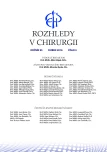Kidney donors after circulatory death (DCD) – single centre experience
Authors:
V. Třeška; T. Reischig; D. Hasman; B. Čertík; J. Moláček; R. Šulc; M. Čechura; L. Kielberger; K. Houdek; V. Opatrný
Authors‘ workplace:
Transplantační centrum LF Univerzity Karlovy a FN v Plzni
přednosta: prof. MUDr. V. Třeška, DrSc.
Published in:
Rozhl. Chir., 2016, roč. 95, č. 4, s. 147-150.
Category:
Original articles
Overview
Introduction:
Kidney procurement from donors after circulatory death (DCD) is an important part of worldwide transplantation programmes. The first kidney transplantation from DCD was successfully performed in the Czech Republic in 2002.
Method:
Forty four kidneys from DCD were procured in the Transplant Centre of Pilsen between 2002 and 2015. We used the technique of “in situ“ procurement with the double balloon triple lumen catheter and 5−10 minutes of the no-touch interval. The method of pulsatile hypothermic perfusion was used to test the viability of the kidneys. Twenty eight recipients with mean age 51.1 (26−73) years were transplanted. Sixteen (57.1%) kidneys were from the 2nd, 8 (28.6%) from the 3rd and 4 (14.3%) from the 4th category according to the Maastricht criteria.
Results:
30-day mortality and morbidity rates were 0 and 10.7% i. e.14.3% respectively (N=4). Primary non-function was presented in 2 (7.1%), and delayed graft function in 5 (17.9%) cases. One, five and ten years of recipient and graft survival rates were 100%, 86.4% and 76.7%; and 92.9%, 69.6% and 61.9%, respectively. The long-term results are fully comparable with kidneys transplanted from donors after brain death.
Conclusion:
DCD are an important source for kidney transplantation. Kidney transplantation from DCD is a logistically, economically and personally demanding method with very good long-term results.
Key words:
donors after circulatory death – kidney transplantation – results
Sources
1. Třeška V, Hasman D, Čechura M, et al. Naše první zkušenosti s transplantacemi ledvin z dárců s nebijícím srdcem. Rozhl Chir 2002;81 : 582−6.
2. Třeška V, Hasman D, Hes O, et al. Dárce s nebijícím srdcem – nová možnost rozšíření dárcovského programu ledvin. Rozhl Chir 2000;79 : 613–8.
3. Kieslichová E. a kol. Dárci orgánů. Praha, Maxdorf 2015.
4. Třeška V. a kol. Transplantologie pro mediky. Praha, Karolinum 2002.
5. Ortega-Deballon I, Homby L, Shemie SD. Protocols for uncontrolled donation after circulatory death: a systematic review of international guidelines, practices and transplant outcomes. Crit Care 2015;19 : 268−80.
6. Koostra G, van Heurn E. Non-heartbeating donation of kidneys for transplantation. Nature Clinical Practice Nephrology 2007;3 : 154–63.
7. Algahim MF, Love RB. Donation after circulatory death: the current state and technical approaches to organ procurement. Curr Opin Organ Transplant 2015;20 : 127−32.
8. Akoh JA. Kidney donation after cardiac death. WJN 2012;1 : 79−91.
9. Detry O, Le Dinh H, Noterdaeme T, et al. Categories of donation after cardiocirculatory death. Transplant Proc 2012;44 : 1189−95.
10. Hosgood SA, Nicholson ML. The first clinical case of intermediate ex vivo normothermic perfusion in renal transplantation. Am J Transpl 2014;14 : 1690−2.
11. Hoogland ER, Snoeijs MG, van Heurn LW. DCD kidney transplantation: results and measures to improve outcome. Curr Opin Organ Transplant 2010;15 : 177−82.
12. Moers C, Smits JM, Maathuis MH, et al. Machine perfusion or cold storage in deceased-donor kidney transplantation. N Engl J Med 2009;360 : 7−19.
13. Watson CJ, Wells AC, Roberts RJ, et al. Cold machine perfusion versus static cold storage of kidneys donated after cardiac death: a UK multicenter randomized controlled trial. Am J Transplant 2010;10 : 1991−9.
14. Bruzzone P. Ethical and legal issues in donation after cardiac death in Italy. Transplant Proc 2010;42 : 1046−47.
15. Gardiner D, Shemie S, Manara A, et al. International perspective on the diagnosis of death. Brit J Anestesth 2012;108 : 14−28.
16. Ribalta A, Gallardo J, Ruiz A, et al. Donation after cardiac arrest program in Catalonia (Spain). Med Clin 2009;10 : 18−21.
Labels
Surgery Orthopaedics Trauma surgeryArticle was published in
Perspectives in Surgery

2016 Issue 4
Most read in this issue
- Skin and soft tissue infections (SSTIs)
- Splenosis as a rare cause of abdominal pain
- Kidney donors after circulatory death (DCD) – single centre experience
- Bouveret syndrome: a case report and literature review
